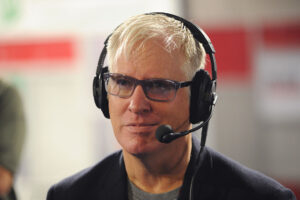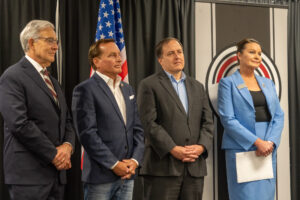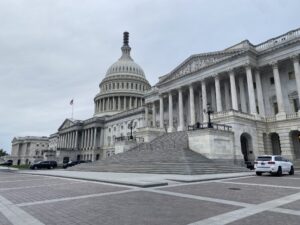5:45
News Story
Social media ads another battleground to reach voters in Missouri governor’s race
Gov. Mike Parson and Auditor Nicole Galloway hope to frame the stakes of November’s election
Depending on your data and interests collected on Facebook, the advertisements pushed online by the two leading candidates for Missouri governor tell two very different stories.
In the spring and early summer, Gov. Mike Parson’s Facebook advertisements focused on his pandemic response and restarting the economy. By July, when cases rose to more than 1,000 a day, the ads shifted to law and order, focusing on opposition to defunding the police and the “liberal mob.”
Meanwhile, Democratic challenger Nicole Galloway’s messaging hasn’t wavered, focusing throughout on criticism of Parson’s pandemic response, while stressing the race is “neck-and-neck.” Some of Galloway’s ads have targeted Missourians who’ve expressed interest on Facebook in topics like feminism, Black Lives Matter, Planned Parenthood or Joe Biden.
While a majority have been shown in Missouri, there’s a chance you might have seen some of Galloway’s campaign Facebook ads as far away as Hawaii or Florida or Texas, as they’ve reached across the country.
While more money – and attention – has been focused on television ads, where both campaigns have accused the other of peddling false claims, a battle to frame the stakes of the election is also playing out on social media.
The Money
Since July 1, Uniting Missouri, a political action committee that supports Parson, has spent about $342,400 on Facebook ads, according to New York University’s Facebook Ad Observatory. Parson’s campaign has spent roughly $64,500.
Over the same time period, Galloway’s campaign has spent around $210,400. A Stronger Missouri, a PAC connected with the Democratic Governors Association that supports Galloway, has spent about $149,900.
All four committees are spending tens of thousands of dollars on advertising on Google and YouTube as well — mostly to promote text ads and television spots. But Galloway is the only one on Snapchat, targeting women 18-29 years old in St. Louis, Kansas City and Springfield with two ads focused on healthcare — an issue that’s been a cornerstone of her campaign’s message.
Galloway’s campaign says the views online have translated to tangible support. Between July 1 and Sept. 30, the campaign says, more than $2 million was raised online, with a 460 percent increase over the previous quarter in donations from online methods like texting and social media.
Of supporters who helped contribute to the roughly $3 million raised that quarter, Galloway’s campaign says 96 percent donated $250 or less and 83 percent were from Missouri.
“We are a campaign that is powered by everyday folks chipping in,” said Caleb Cavarretta, Galloway’s deputy campaign manager.
By using social media to advertise outside Missouri, Galloway is likely reaching out-of-state donors who can’t vote for her but who will support her financially through what Greg Vonnahme, an associate professor of political science at the University of Missouri-Kansas City, called “monetary surrogacy.”
“Really,” Vonnahme said, “the only reason that any state official or congressional figure or anybody would run ads outside of their district or outside of their state, is to raise money.”
A spokesman for Parson’s campaign did not respond to a request for comment on donations raised online or first time donors. Parson’s social media ads nearly all focus on Missouri.
Michael Berg, a spokesman for Uniting Missouri, said he’s confident Parson’s messaging is resounding with Missouri voters, pointing to recent polls that have shown Parson ahead.
“I think we’re still the loudest voice in the room in Missouri when it comes to getting our message out,” Berg said.
By seizing on interest online, campaigns have an opportunity to turn those views into larger turnout, said Daniel Ponder, a professor of political science at Drury University in Springfield.
“That also indicates an easy way to try to convert those dollars into votes. And not just those dollars into ads,” Ponder said.
Political observers have marked the Missouri governor’s race as one of the more competitive ones nationwide.
Many of Galloway’s Facebook advertisements have focused on that horse-race message. By casting it as a close race, Democrats hope to motivate their voters to turn out, said Robynn Kuhlmann, an associate professor of political science at the University of Central Missouri.
“If the Galloway campaign makes it seem like it’s a close race, then perhaps they may be able to garner a few more votes in this election, when voters may have otherwise thought that she was going to be a sure loser,” Kuhlmann said.
COVID vs. law and order
Parson’s first Facebook advertisement that mentioned the novel coronavirus ran in late March, back when Missouri was just surpassing its first 100 confirmed cases. He touted frequent updates on his actions, promoting clips of his COVID-19 briefings and tallying up the executive orders issued.
By the beginning of May his message began to shift toward reopening the state and rebuilding Missouri’s economy. And by late July, after demonstrations decrying police brutality had been held nationwide, Parson pointed to his record as the former Polk County sheriff while vowing to support law enforcement against “liberal mobs.”
COVID-19 wasn’t mentioned among his Facebook advertisements again until September, when Parson’s page promoted a television advertisement praising his response. While Parson’s campaign ran ads on law and order, Uniting Missouri has used social media to try and paint Galloway as an extremist who is beholden to the liberal wing of her party on issues like guns, abortion and immigration.
GET THE MORNING HEADLINES.
Meanwhile, Galloway criticized Parson for his handling of the pandemic, stressing how she would have responded differently. Stronger Missouri promoted ads featuring television spots that attacked Parson for his previous acceptance of lobbyist gifts and highlighted his opposition to Medicaid expansion.
Kevin Donohue, a spokesman for Galloway’s campaign, said Parson’s shifting messages reflect difficulty connecting with Missourians.
“They have struggled to clearly define the case for why he should be elected in November,” Donohue said.
Berg pushed back on that assertion, saying Parson has struck a balance between stressing the need to take the virus seriously while advocating for the need for Missouri to reopen its economy safely.
“If you’re not talking about the economy right now you are off track in terms of your messaging and what’s important and on voters’ minds,” Berg said.
Regardless of what message runs on social media, the pandemic will remain the major issue in this election.
“You sort of ignore at your own risk,” Vonnahme said.
Our stories may be republished online or in print under Creative Commons license CC BY-NC-ND 4.0. We ask that you edit only for style or to shorten, provide proper attribution and link to our website. AP and Getty images may not be republished. Please see our republishing guidelines for use of any other photos and graphics.





